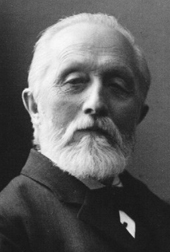
Digenea is a class of trematodes in the Platyhelminthes phylum, consisting of parasitic flatworms with a syncytial tegument and, usually, two suckers, one ventral and one oral. Adults commonly live within the digestive tract, but occur throughout the organ systems of all classes of vertebrates. Once thought to be related to the Monogenea, it is now recognised that they are closest to the Aspidogastrea and that the Monogenea are more closely allied with the Cestoda. Around 6,000 species have been described to date.

Louis Marie Adolphe Olivier Édouard Joubin was a professor at the Muséum national d'Histoire naturelle in Paris. He published works on nemerteans, chaetognatha, cephalopods, and other molluscs.

Theodor Becker was a Danish-born German civil engineer and entomologist primarily known for studies on the taxonomy of flies.
La Société zoologique de France, founded in 1876 by Aimé Bouvier, is a scientific society devoted to Zoology. It publishes a bulletin and organises the Prix Gadeau de Kerville de la Société zoologique de France.

Henri Gadeau de Kerville was a French zoologist, entomologist, botanist and archeologist best known for his photographs of these subjects and especially for his work "Les Insectes phosphorescents: notes complémentaires et bibliographie générale : avec quatre planches chromolithographiées", Rouen, L. Deshays, 1881.
Cyclocoelidae is a family of trematodes in the order Plagiorchiida.

Plagiorchiida is a large order of trematodes, synonymous to Echinostomida. They belong to the Digenea, a large subclass of flukes. This order contains relatively few significant parasites of humans.
Opisthorchiata is a suborder of flatworms in the subclass Digenea.

Opecoelidae is a family of trematodes. It is the largest digenean family with over 90 genera and nearly 900 species, almost solely found in marine and freshwater teleost fishes. It was considered by Bray et al. to belong in the superfamily Opecoeloidea Ozaki, 1925 or the Brachycladioidea Odhner, 1905.

Jean Baptiste François René Koehler was a French zoologist best known for his research of echinoderms.
Telorchiidae is a family of trematode parasites.
Chabertia ovina, the large-mouthed bowel worm, is a species of parasitic roundworms that infects sheep, goats and other wild ruminants. Infection of pigs are very infrequent. It is not known to be contagious to humans.
Philophthalmidae is a family of trematodes in the order Plagiorchiida.

Echinostomatidae Looss, 1899 is a family of trematodes in the order Plagiorchiida. Cathaemasiidae Fuhrmann, 1928 is a synonym of it.
Himasthlidae is a family of trematodes in the order Plagiorchiida.
Echinochasmidae is a family of trematodes in the order Plagiorchiida.
Gymnophallidae is a family of trematodes in the order Plagiorchiida.
Gorgoderidae is a family of trematodes in the order Plagiorchiida.
Echinochasmus is a genus of trematodes in the family Echinochasmidae.
Nils Johan Teodor Odhner was a Swedish zoologist. Odhner was born in Lund, Sweden. He was the son of the historian Clas Theodor Odhner and the father of the agronomist Clas-Erik Odhner.








